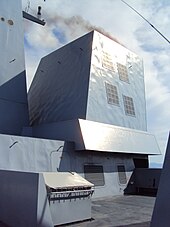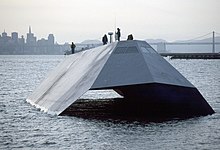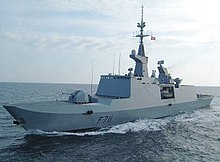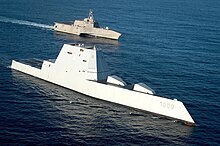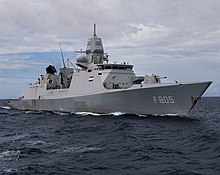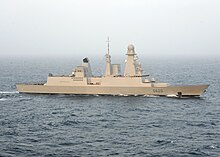
A frigate is a type of warship. In different eras, the roles and capabilities of ships classified as frigates have varied.
The United States Navy, United States Coast Guard, and United States National Oceanic and Atmospheric Administration (NOAA) use a hull classification symbol to identify their ships by type and by individual ship within a type. The system is analogous to the pennant number system that the Royal Navy and other European and Commonwealth navies use.

An anti-ship missile is a guided missile that is designed for use against ships and large boats. Most anti-ship missiles are of the sea-skimming variety, and many use a combination of inertial guidance and active radar homing. A large number of other anti-ship missiles use infrared homing to follow the heat that is emitted by a ship; it is also possible for anti-ship missiles to be guided by radio command all the way.

A corvette is a small warship. It is traditionally the smallest class of vessel considered to be a proper warship. The warship class above the corvette is that of the frigate, while the class below was historically that of the sloop-of-war.

The Visby class is a series of corvettes in use by the Swedish Navy. It is the latest class of corvette adopted by the navy after the Göteborg and Stockholm-class corvettes. Its design emphasizes low visibility radar cross-section and infrared signature, and the class has received widespread international attention because of its capabilities as a stealth ship. The first ship in the class is named after Visby, the main city on the island of Gotland.

A warship or combatant ship is a ship that is built and primarily intended for naval warfare. Usually they belong to the armed forces of a nation. As well as being armed, warships are designed to withstand damage and are typically faster and more maneuverable than merchant ships. Unlike a merchant ship, which carries cargo, a warship typically carries only weapons, ammunition and supplies for its crew. Warships usually belong to a navy, though they have also been operated by individuals, cooperatives and corporations.

A vertical launching system (VLS) is an advanced system for holding and firing missiles on mobile naval platforms, such as surface ships and submarines. Each vertical launch system consists of a number of cells, which can hold one or more missiles ready for firing. Typically, each cell can hold a number of different types of missiles, allowing the ship flexibility to load the best set for any given mission. Further, when new missiles are developed, they are typically fitted to the existing vertical launch systems of that nation, allowing existing ships to use new types of missiles without expensive rework. When the command is given, the missile flies straight up far enough to clear the cell and the ship, then turns onto the desired course.

The La Fayette class is a class of general purpose frigates built by DCNS in the 1980s and 90s, operated by the French Navy and three other navies. Derivatives of the type are in service in the navies of Saudi Arabia, Singapore, and Taiwan.

Skjold-class corvettes are a class of six light, superfast, stealth missile corvettes in service with the Royal Norwegian Navy. The boats were formerly classed as MTBs but, from 2009, the Royal Norwegian Navy has described them as corvettes (korvett) because their seaworthiness is seen as comparable to corvettes, and because they do not carry torpedoes. They were built at the Umoe Mandal yard. With a maximum speed of 55 knots (102 km/h), the Skjold-class corvettes were the fastest combat ships afloat at the time of their introduction., as of 2023 beaten by the Abu Dhabi MAR WP-18 Interceptor.

The Republic of China Navy is the maritime branch of the Republic of China Armed Forces (ROCAF).

DARDO originally known as Breda Type-70, also marketed as the OTO Twin 40L70 Compact, is a close-in weapon system (CIWS) built by the Italian companies Breda and Oto Melara. It is composed of two Breda-built Bofors 40 mm firing high explosive (HE) shells, a fire-control radar and a fire-control system. It is the last of a long series of Italian anti-aircraft weapons derived from the Swedish Bofors 40 mm autocannons.

Mazagon Dock Shipbuilders Limited (MDL), formerly called Mazagon Dock Limited, is a shipyard situated in Mazagaon, Mumbai. It manufactures warships and submarines for the Indian Navy and offshore platforms and associated support vessels for offshore oil drilling. It also builds tankers, cargo bulk carriers, passenger ships and ferries.

The Cheng Kung-class frigates are eight guided-missile frigates in service in the Republic of China Navy (ROCN). They are based upon the U.S. Oliver Hazard Perry class and built by China Shipbuilding Corporation in Kaohsiung, Taiwan under license throughout the 1990s as part of the Kuang Hua I project. These frigates served as the mainstay of the ROCN's area air defense capability prior to the acquisition of the Keelung (Kidd)-class destroyers in 2005. They are designated with the hull classification PFG rather than FFG used by the Oliver Hazard Perry class.

The Kedah-class offshore patrol vessels of the Royal Malaysian Navy (RMN) are six ships based on the MEKO 100 design by Blohm + Voss. Originally, a total of 27 ships were planned, but due to programme delays and overruns, only six were eventually ordered. Their construction began in the early 2000s, and by 2009, all six were in active service. The six vessels are named after Malaysian states.
The Royal Canadian Navy uses hull classification symbols to identify the types of its ships, which are similar to the United States Navy's hull classification symbol system. The Royal Navy and some European and Commonwealth navies use a somewhat analogous system of pennant numbers.
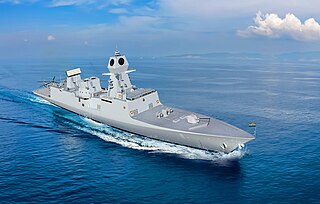
The Nilgiri-class frigates, formally classified as the Project-17 Alpha frigates (P-17A), are a series of stealth guided-missile frigates currently being built by Mazagon Dock Shipbuilders (MDL) and Garden Reach Shipbuilders & Engineers (GRSE), for the Indian Navy. The seventh and final ship of the Project 17A frigates, named Mahendragiri, was launched on 1 September 2023 at the Mazagon Dock by Dr Sudesh Dhankhar, wife of Indian vice-president Jagdeep Dhankhar. It is expected to be commissioned in 2024.

The Tuo Chiang-class corvette is a Taiwanese-designed class of fast and stealthy multi-mission corvettes built for the Republic of China (Taiwan) Navy. It is designed to counter the numerous and increasingly sophisticated People's Liberation Army Navy ships by utilizing hit-and-run tactics, and thus features clean upper structure design with very few extrusions to reduce radar signature, pre-cooled engine exhaust to reduce infrared signature, and a reduced visual signature to reduce chance of detection.

The Visakhapatnam-class destroyers, also classified as the P-15 Bravo class, or simply P-15B, is a class of guided-missile destroyers currently being built for the Indian Navy. The Visakhapatnam class is an upgraded derivative of its predecessor, the Kolkata class, with improved features of stealth, automation and ordnance.
Next Generation Missile Vessels (NGMVs) are a planned class of anti-surface warfare corvettes for the Indian Navy. Under this programme the Indian Navy intends to acquire six advanced missile vessels. Ships in this class will be armed with Anti-ship missile or Land-attack missile like BrahMos. Ships under this class will feature advanced stealth features like a low radar cross section (RCS), infrared, acoustic and magnetic signatures.

